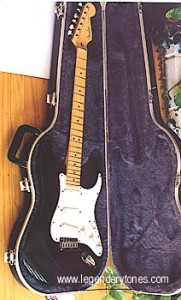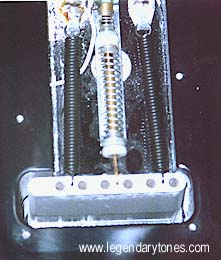The Fender Stratocaster’s design, tone, and roster of famous past and current players clearly make it a legendary guitar. As with any other guitar model however, certain designs invoke a special feeling which deem it to be a classic or at least a legend in the making. The most prized Fender Stratocasters today are those known as pre-CBS (prior to the sale of Fender Musical Instruments to CBS in 1965) models, produced from 1954 through the early 1965. These instruments have a certain unique feel and sound as well as being historically significant since they were produced during some of the most interesting eras of rock and roll itself. As we moved into the 70’s, the Stratocaster became a more popular and more widely produced guitar, but also one that was constructed with less attention to detail. As a result of poorer quality control and materials used, the 70’s were seen as the low point of the Stratocaster.
Enter the 1980’s. Fender Musical Instruments is sold again and with somewhat strained resources, a commitment by the new management team to return Fender to its glory days of providing quality instruments at affordable prices is made. The American Standard Stratocaster is born. A design which implements the best of the classics of the 50’s and 60’s with modern enhancements, the American Standard Stratocaster was a winner and helped propel Fender Musical Instruments into the top guitar manufacturer where it sits today.
 As Fender’s sales grew, the company began to offer more models with different options to keep up with the varying needs of different musicians. The Fender Stratocaster Plus model was first offered in the late 80’s and featured many unique design firsts in a Stratocaster. It incorporated a special nut that reduced friction when using the tremolo and featured locking tuners to increase tuning stability. The Strat Plus also used Don Lace’s new Lace Sensor pickups. Lace Sensors were quite unique in that they did not employ traditional magnetics to produce sound. Lace Sensor pickups therefore could be adjusted as high up to the strings as desired with no issue of string pull occurring. They also were virtually noiseless – the effect of having a humbucking pickup while retaining the tone of a single coil.
As Fender’s sales grew, the company began to offer more models with different options to keep up with the varying needs of different musicians. The Fender Stratocaster Plus model was first offered in the late 80’s and featured many unique design firsts in a Stratocaster. It incorporated a special nut that reduced friction when using the tremolo and featured locking tuners to increase tuning stability. The Strat Plus also used Don Lace’s new Lace Sensor pickups. Lace Sensors were quite unique in that they did not employ traditional magnetics to produce sound. Lace Sensor pickups therefore could be adjusted as high up to the strings as desired with no issue of string pull occurring. They also were virtually noiseless – the effect of having a humbucking pickup while retaining the tone of a single coil.
By the mid 90’s, the Strat Plus was a fully refined machine and incorporated more modern features such as a Hipshot Tremsetter (pictured) and a new LSR roller nut design (also pictured) to eliminate string "hang ups" and significantly improve tuning stability. The LSR roller nut eliminated the friction of the strings resting inside the nut itself because they were now positioned on ball-bearings. Notice in the photo that with the LSR roller nut, string retainers were no longer needed and this also assisted with maintaining tuning stability. With the machined ball-bearing and aluminum nut design, there were no longer issues with manufacturing imperfections such as those found with plastic nuts, which most luthiers will admit take quite a bit of skill to cut correctly. The Hipshot Tremsetter, mounted in the body cavity in the middle of the tremolo springs, ensured that the tremolo would return to the exact same floating position during use.
 There were other variations of the Strat Plus, such as the Strat Plus Deluxe that added different flavors of the Lace Sensors in each of the different pickup positions as well as adding a custom pearloid pick guard and Floyd-Rose designed tremolo. The Strat Plus models overall were a highlight of mid 90’s production-made Stratocasters and were also quite a bargain compared to guitars made from Fender’s Custom Shop.
There were other variations of the Strat Plus, such as the Strat Plus Deluxe that added different flavors of the Lace Sensors in each of the different pickup positions as well as adding a custom pearloid pick guard and Floyd-Rose designed tremolo. The Strat Plus models overall were a highlight of mid 90’s production-made Stratocasters and were also quite a bargain compared to guitars made from Fender’s Custom Shop.
For those looking for the genuine Stratocaster tone but also desiring modern improvements such as low pickup noise and added tuning stability, Fender’s Stratocaster Plus series should be looked at with serious consideration. In today’s market, these guitars are still very attractively priced and are certain to command a premium in the years ahead.